Next-generation medicines
How researchers are using genes, cells and tissues to create a new generation of advanced therapies.
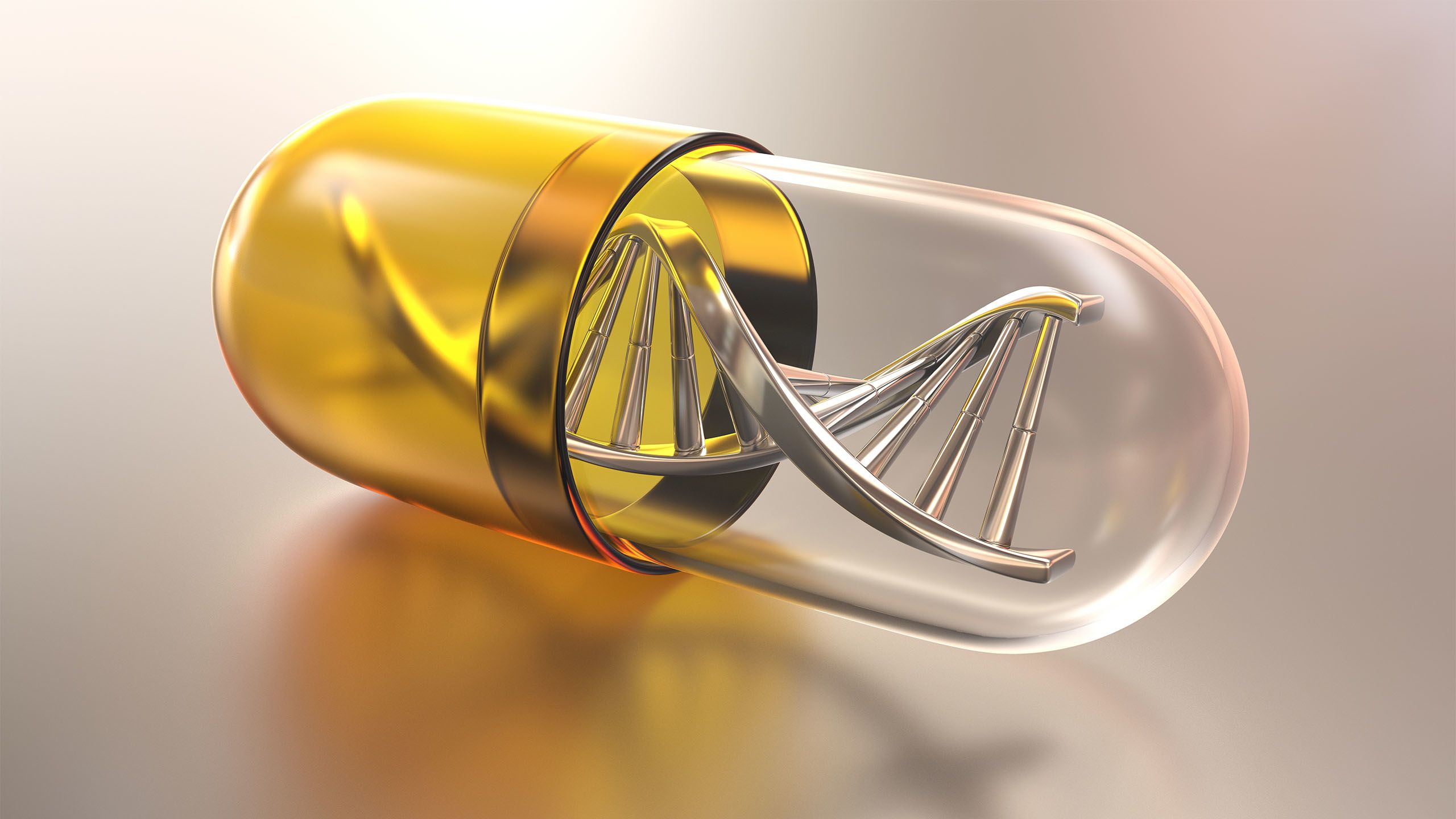
Professor Nagy Habi had a Eureka moment while pedalling an exercise bike during a lunchtime gym session. “I thought to myself ‘If I’m in the gym, I can’t also be in the operating theatre or watching a play in the West End’,” says Habib, Professor of Hepatobiliary Surgery at Imperial. “I wondered whether it might be the same for liver cells. Perhaps they can either use their energy to produce albumin or to power cell division, but not both at the same time.”
We began to wonder whether we could treat liver cancer by increasing the expression of a gene that improves liver function.
Albumin prevents fluid leaking out of blood vessels, and transports hormones, vitamins and other important substances around the body. The protein was on Professor Habib’s mind because his patients with liver damage have low levels of it. After his exercise session, he called a colleague with whom he was investigating the use of a small activating ribonucleic acid (saRNA) to treat liver disease. “I asked him whether our cell cultures producing albumin also had lower cell counts, and he said ‘Yes, Prof’. That’s when we began to wonder whether by increasing the expression of a gene to improve liver function, we could at the same time treat liver cancer.”
Ten years on and MiNA Therapeutics, a company co-founded by Professor Habib, is running the world’s first clinical trials of therapeutic saRNAs. The groundbreaking work has only been possible because Professor Habib was keenly aware of the importance of working with those in other fields and harnessing the talents of colleagues in both academia and industry. In reaching out beyond traditional boundaries, Professor Habib’s approach has much in common with other leading researchers at Imperial’s Centre for Advanced Therapeutics.
The Centre for Advanced Therapeutics
Launched in early 2020, Imperial's Centre for Advanced Therapeutics brings together pioneers in the fields of RNA therapeutics, biomaterials, cardiology, haematology, respiratory medicine, neurology, vaccines and vectorology.
It facilitates the sharing of ideas, expertise, facilities and training to speed the development of new treatments. Gene- and cell-based therapies, and tissue engineering – collectively known as Advanced Therapeutic Medicinal Products (ATMPs) – make up most of the Centre’s focus.
Some ATMPs have been improving the lives of patients for several years, while others being researched have the potential to revolutionise the treatment of a wide range of conditions.
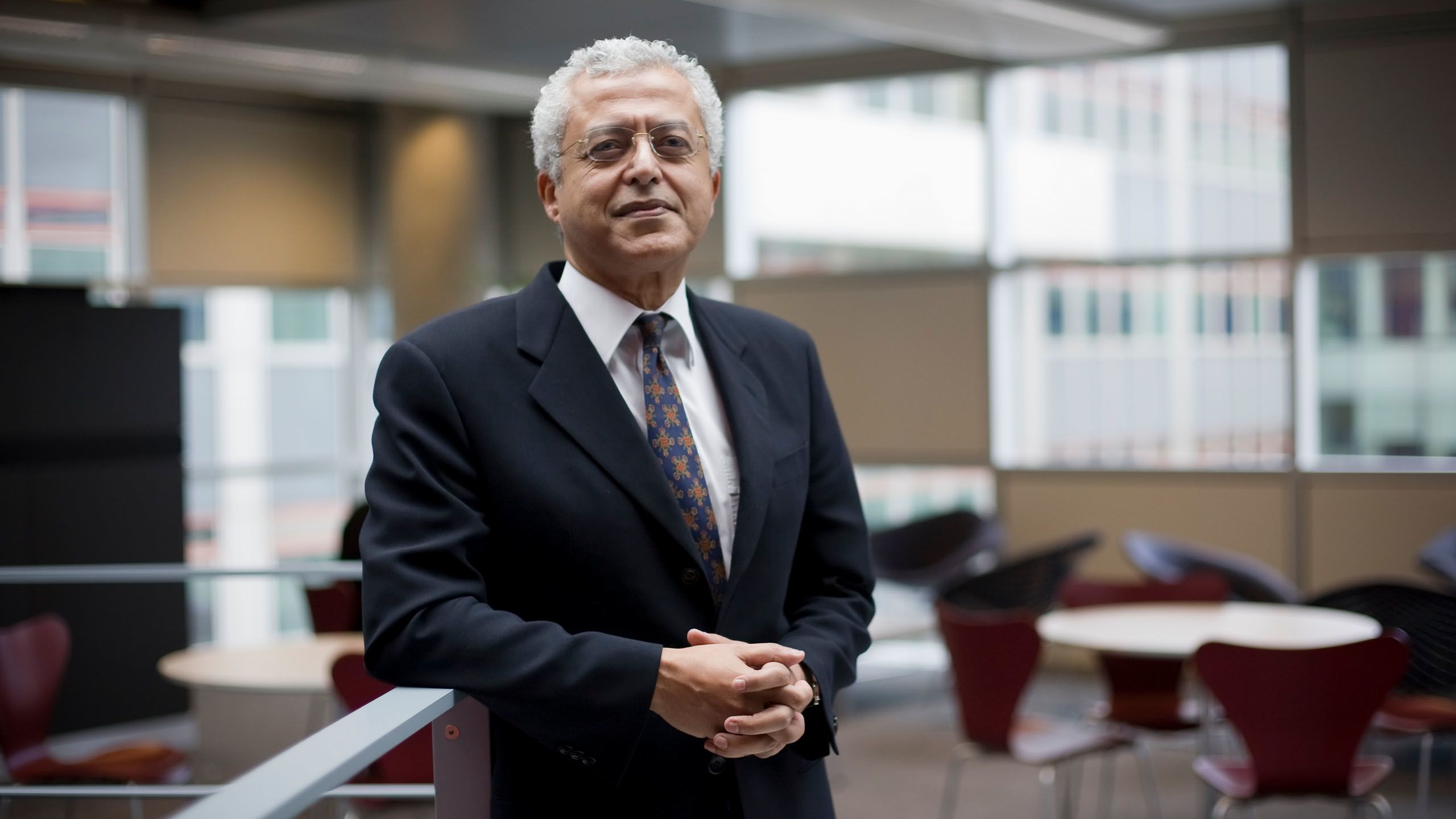
Professor Nagy Habib is is a leading translational researcher on liver cancer and its treatment and founder of MiNa Therapeutics, which is developing RNA-based therapies for a range of diseases.
Professor Nagy Habib is is a leading translational researcher on liver cancer and its treatment and founder of MiNa Therapeutics, which is developing RNA-based therapies for a range of diseases.
RNA and liver disease
Before he began working with saRNA, Professor Habib led a pioneering clinical trial of the use of adult stem cells to treat chronic liver disease. The results, published in 2006, showed indications of benefits including increased albumin levels, but the effects were not strong enough to justify larger trials. Primarily a clinician, Professor Habib arranged a weekly call with three scientist friends in America to discuss new approaches. “I know my patients but I know little molecular biology. We spoke every week for about three years until we had the science sorted out.”
Professor Habib’s group discussed using gene therapy, however they were also interested in the emerging field of RNA therapeutics as a transient, reversible and safe way to regulate gene expression. RNA-targeting approaches, they realised, could avoid some of the concerns about gene therapy causing side effects linked to permanent changes to DNA. In 2006, a separate group at the University of California San Francisco reported that they had used saRNAs to activate the production of specific proteins.
Hepatocellular carcinoma (HCC), the most common form of liver cancer in adults, occurs most often in patients with chronic liver diseases, such as cirrhosis from hepatitis virus infection, alcohol abuse or non-alcoholic fatty liver disease. Only a minority of cases can be treated with surgery, reoccurrence is common, and existing drugs have limited effects.
Having long treated patients with HCC, Professor Habib was well aware of the need for new treatments to improve outcomes. He and his collaborators began investigating ways to use RNA to activate genes to restore normal, healthy protein production. Initially, they hoped saRNAs could be used to improve the impact of stem cell therapy by activating genes in order to help maintain the ability of stem cells to self-renew and differentiate into diverse cell types. Early research successes led them to switch to investigating saRNAs as medicines in their own right. MiNA Therapeutics was formed in 2008.
Having long treated patients with liver cancer, Professor Habib was well aware of the need for new treatments to improve outcomes. He and his collaborators began investigating ways to use RNA to activate genes to restore normal, healthy protein production.
Professor Habib and his collaborators selected the CCAAT/enhancer-binding protein alpha (CEBPA) gene as a target because it is a master regulator of a number of functions linked to liver cancer. They generated saRNA molecules to up-regulate CEBPA, and, in 2013, showed that injecting them into rats with HCC increased their albumin levels, improved liver function and inhibited tumour growth. After optimising their synthetic saRNA to increase its ability to increase CEBPA expression, and following further tests, the group formulated it in a liposome nanoparticle.
The result, called MTL-CEBPA, is being evaluated in clinical trials for the treatment of advanced solid tumours and HCC in combination with other drugs. MiNA Therapeutics has recently established a number of high profile collaborations with pharmaceutical companies to investigate the further potential of saRNA medicines.
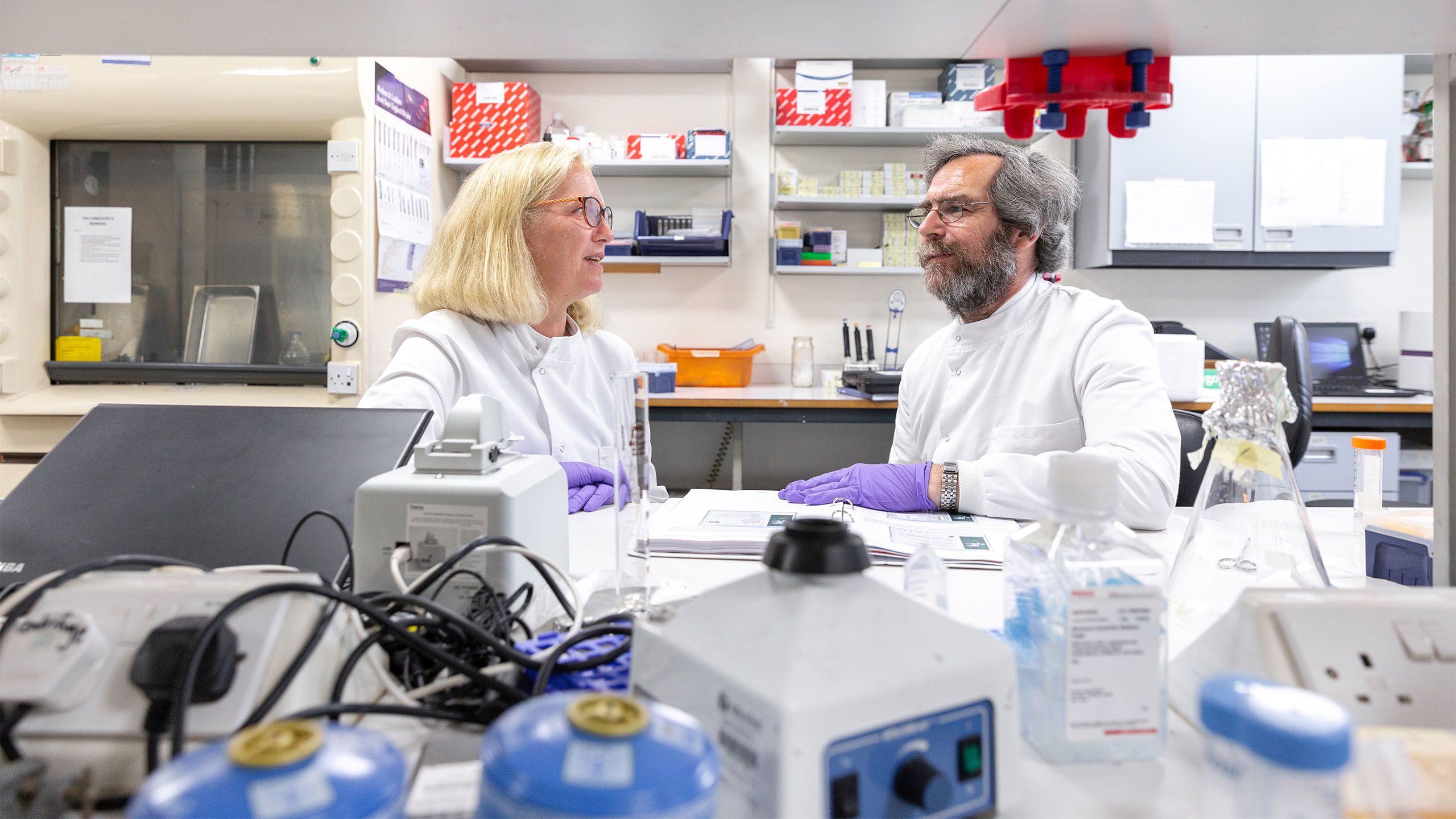
Gene therapy pioneers Professors Uta Griesenbach and Eric Alton are working with Boehringer-Ingelheim and Oxford BioMedica to commercially develop a therapy for cystic fibrosis. They lead the Centre for Advanced Therapeutics at Imperial.
Gene therapy pioneers Professors Uta Griesenbach and Eric Alton are working with Boehringer-Ingelheim and Oxford BioMedica to commercially develop a therapy for cystic fibrosis. They lead the Centre for Advanced Therapeutics at Imperial.
Gene therapy and cystic fibrosis
Eric Alton, Professor of Gene Therapy and Respiratory Medicine at Imperial's National Heart and Lung Institute (NHLI), is another clinician who understands the immense value of collaborating with laboratory-based colleagues in different fields. In the 1980s, Professor Alton carried out pioneering work that revealed in greater detail the causes of abnormalities in the flow of sodium and chloride across mucous membranes in the noses of those with cystic fibrosis. His research led to the worldwide introduction of a diagnostic test based on identifying the greater differences in the voltage of electrical signals across membranes lining nasal cavities in those with the condition.
Cystic fibrosis is an inherited disease caused by abnormalities in the CF transmembrane conductance regulator (CFTR) gene. The identification and cloning of the CFTR gene in 1989 raised hopes that the condition might be treatable with gene therapy. Researchers investigated different ways to get healthy versions of the CFTR gene into the airways of patients. Many of the early gene therapy trials of the 1990s used either adenoviruses or adeno-associated viruses as vectors. While this showed some promise, neutralising immune responses often rendered repeat administration ineffective.
Early gene therapy trials for cystic fibrosis used viruses as vectors. While this showed some promise, neutralising immune responses often rendered repeat doses ineffective. Professors Alton and Griesenbach have developed a non-viral approach using lipid coatings.
Groups at Imperial and the Universities of Oxford and Edinburgh formed the UK CF Gene Therapy Consortium in 2001 to better coordinate their efforts, with Professor Alton as its lead coordinator. By this time, he had been joined at Imperial by Professor Uta Griesenbach, a geneticist who moved to NHLI from the Canadian laboratory that discovered the CFTR gene. She and Professor Alton, who share a keen focus on taking science beyond the lab and into the clinic, have worked together for over 20 years.
They and their colleagues adopted a multi-pronged strategy in their search for improved cystic fibrosis treatment. Their non-viral approach involved encasing healthy versions of the CFTR gene in lipid coatings called liposomes. They completed the world’s largest cystic fibrosis gene therapy trial in 2015. “We showed for the first time that repeated doses of gene therapy can make a difference to lung function compared to placebo,” says Professor Alton.
While this was promising, the effects were seen as too modest to form the basis for a commercially viable product. In parallel, the group had been working with Japanese researchers on an alternative viral vector-based approach. Using a process called pseudotyping, they added proteins from the murine Sendai virus to a simian lentivirus to produce a vector that could effectively enter cells that make up airway linings while evading the immune reactions that reduce the efficacy of other viral vectors.
“Adenoviruses and adeno-associated viruses are widely used as vectors, but when you come to give second and third doses they induce immune responses, so they don’t work as well,” says Professor Griesenbach. “We and others have shown lentiviruses seem to be immunologically privileged, so you can give repeated doses without losing efficacy.”
Professor Griesenbach has also shown their lentivirus-based gene therapy platform can drive efficient secretion of proteins. Based on this work, she and Professor Alton received a large Wellcome Trust grant to investigate the technology’s potential to treat a number of other lung conditions, such as alpha-1 antitrypsin deficiency, interstitial lung disease and pulmonary alveolar proteinosis, as well as blood disorders including thrombotic thrombocytopenic purpura.
Industry partnerships at the ATMP centre
Professors Alton and Griesenbach are respectively Director and co-Director of the Centre for Advanced Therapeutics. They envision it as a hub where researchers can discuss ideas, share facilities, develop collaborations, coordinate training, and foster links with industry and patients.
“We had pockets of excellence in cell and gene therapy and tissue engineering at Imperial, but we needed more focus to take it to the next level,” says Professor Alton. “An obvious way to produce a more efficient pipeline was to pull together our experience and ideas across different faculties, and link them to patients in our surrounding NHS healthcare trusts.”
The pair are also keen to work with commercial partners to drive translational research. Since 2018, the UK CF Gene Therapy Consortium has been working in partnership with Oxford BioMedica, the gene and cell therapy company, and pharmaceutical company Boehringer Ingelheim. The collaboration is taking the lentivirus-based gene therapy approach through toxicology testing and optimising it for manufacturing, in the hope of taking it through a successful large-scale clinical trial.
The Centre for Advanced Therapeutics leadership is also in discussions about joining up with others at Imperial, including the Translation & Innovation Hub, and the Centre for Synthetic Biology, to form a partnership through which companies sponsoring research may be able to get early sight of research data and findings.
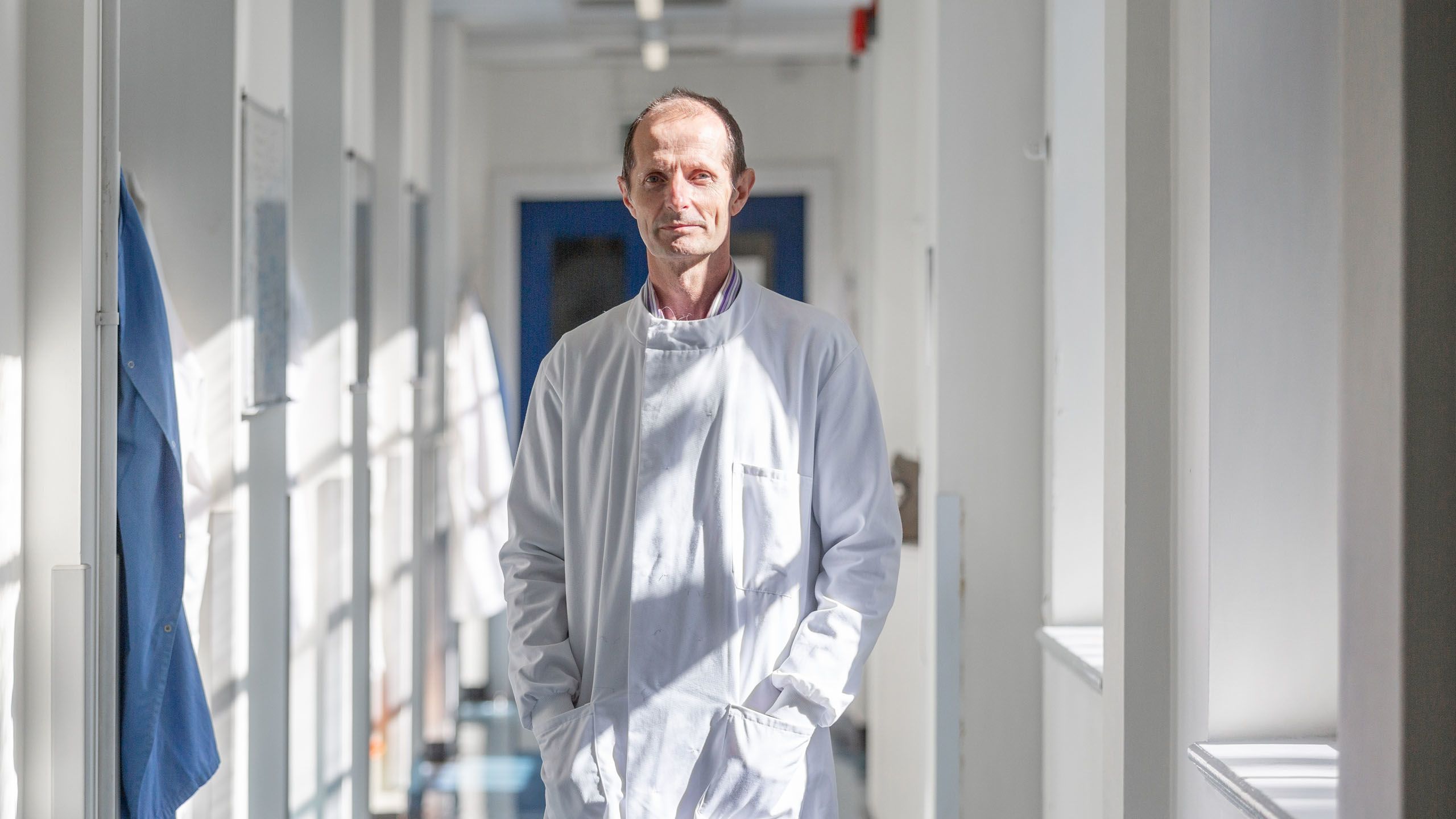
Professor Robin Shattock is developing a COVID-19 vaccine using a novel self-amplifying RNA platform. The technology could allow vaccines to be delivered at much lower doses than mRNA vaccines.
Professor Robin Shattock is developing a COVID-19 vaccine using a novel self-amplifying RNA platform. The technology could allow vaccines to be delivered at much lower doses than mRNA vaccines.
RNA vaccines and COVID-19
Professor Robin Shattock, Head of Mucosal Infection and Immunity at Imperial, also understands the importance of commercial partnerships when developing new treatments. Professor Shattock’s profile skyrocketed during 2020 thanks to his lab’s development of a self-amplifying RNA COVID-19 vaccine. The first mRNA-based COVID-19 vaccines, those developed by BioNTech-Pfizer and NIH-Moderna, have been hugely important in combating the pandemic, but many in the field consider them to be just the first generation of mRNA vaccines. While they deliver genetic instructions to cells to make the spike protein of SARS-CoV-2, a self-amplifying RNA vaccine does this alongside an enzyme that copies those instructions, enabling longer-lasting effects and lower doses.
In the summer of 2020, in partnership with a venture capital group, Professor Shattock set up the company VaxEquity to develop and commercialise his group’s self-amplifying RNA vaccine technology. “It will enable us to attract the investment to get over what some called the valley of death between discovery and a real treatment,” he says. “We don't have the resources of some of the big pharmaceutical companies, so we’re always open to interesting partnerships.”
Professor Shattock’s group is also working on ways to improve the thermal stability of RNA vaccines to allow their storage in normal fridges and even, one day, at room temperature. This could reduce costs and enable their use in countries without the cold chain infrastructure needed to support today’s mRNA vaccines.
Professor Shattock’s profile skyrocketed after developing a self-amplifying RNA COVID-19 vaccine. The vaccine uses an enzyme that enables longer-lasting effects at a lower dose.
Self-amplifying RNA COVID-19 vaccines require smaller quantities of the lipid nanoparticle to encase them, allowing manufacturing more doses at lower cost. The sections of genetic code used are, however, longer, making them harder to produce. It’s a challenge Professor Shattock says his group has overcome.
Early studies suggest their candidate vaccine generates immune responses and is safe to use. However, the level of immune response could be improved by reducing innate restriction of RNA expression. In research published in March, Professor Shattock’s group produced early data showing proteins that inhibit innate immune system responses can be encoded into self-amplifying RNA vectors to modulate RNA replication and protein expression. A second-generation vaccine based on this concept has recently entered clinical trials with data anticipated in early 2022.
The current excitement around the potential of self-amplifying RNA technology extends well beyond its use against COVID-19. Other infectious diseases are an obvious target. Professor Shattock hopes to apply it to conditions including Ebola, Lassa fever and Marburg virus disease, and plans to investigate its potential in the hunt for HIV vaccines and to combat antimicrobial resistance.
VaxEquity has recently announced a partnership with AstraZeneca that will explore applications of the technology to a range of areas including infectious diseases, cancer, and respiratory medicine.
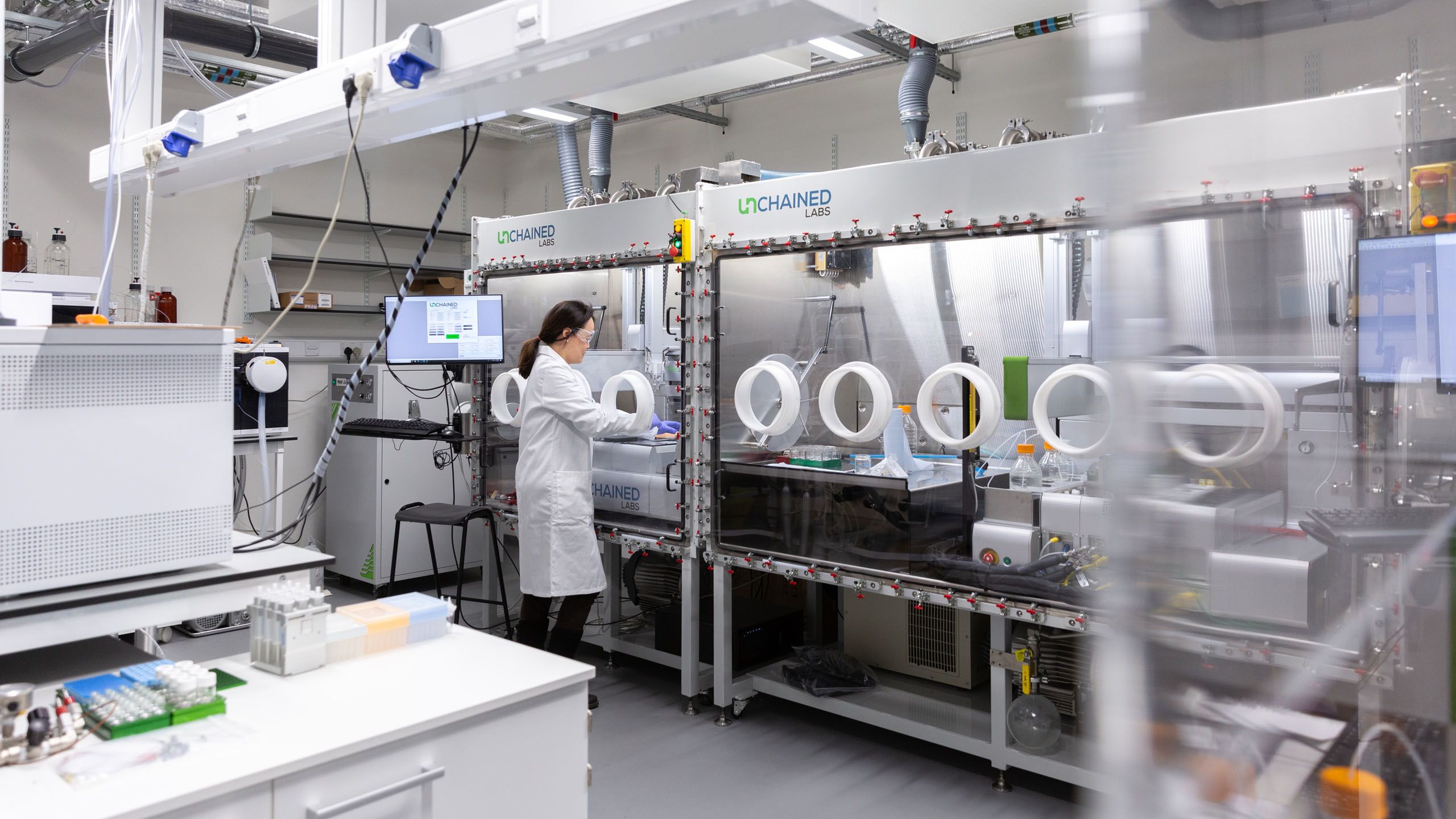
The Centre for Rapid Online Analysis of Reactions (ROAR) offers state-of-the-art facilities to enable data-centric research in synthesis. Pictured using the equipment is Professor Mimi Hii, the Director of ROAR.
The Centre for Rapid Online Analysis of Reactions (ROAR) offers state-of-the-art facilities to enable data-centric research in synthesis. Pictured using the equipment is Professor Mimi Hii, the Director of ROAR.
Automated chemistry
Dr Elena Sanna, a Research Associate in Imperial’s Department of Chemistry, is already working in collaboration with a commercial partner, a startup called Sixfold Bioscience, in her work to improve the efficacy of RNA nanoparticle-based drugs.
A growing body of research has shown how short sections of double-stranded RNA called small interfering RNAs (siRNAs) can be used to turn off the expression of genes linked to disease. While groups around the world are seeking to use the technique to develop new cancer therapies, a remaining obstacle is that, because of their relatively large size, most siRNAs that make it into tumour cells get stuck within cellular waste disposal systems called endosomes, undermining their efficacy.
Small interfering RNAs can be used to turn off the expression of genes linked to disease, however most siRNAs that make it into tumour cells get stuck within cellular waste disposal systems. Dr Sanna is using high-throughput instruments to look for endosomal escape molecules, which can lend a helping hand.
Dr Sanna is trying to discover compounds called endosomal escape molecules (EEMs) that can be attached to RNA nanoparticles to give them a helping hand to break free of the lysosome. She is doing so using facilities at the Centre for Rapid Online Analysis of Reactions (ROAR), based in Imperial’s Molecular Sciences Research Hub at the White City Campus.
ROAR, launched in 2019, provides access to a wide range of automated rapid-throughput instruments. This allows Dr Sanna to rapidly carry out huge numbers of experiments, varying conditions such as temperature, solvents, reagents and reaction times, to identify EEMs and the best ways to chemically bond them to RNA nanoparticles. The ultimate goal is for Dr Sanna’s EEMs to be used to improve the efficacy of siRNAs currently being developed by Sixfold as novel cancer treatments, and the technology could also be applied more broadly.
It has been estimated that getting a new drug through clinical trials and to regulatory approval costs around $1 billion. Using facilities like ROAR, researchers can identify new treatments more quickly and cheaply. Most importantly, that means patients getting access to more effective therapies more quickly.
Quality control
Other cutting edge technologies being developed at Imperial are also helping to smooth the path from the laboratory to the clinic for promising medical research. Professors Alton and Griesenbach are, for example, able to determine the composition and purity of samples of their lentivirus-based vector precisely using Single Particle Automated Raman Trapping Analysis (SPARTA®). This technology was developed by a team led by Molly Stevens, Professor of Biomedical Material and Regenerative Medicine, at Imperial.
SPARTA® works by optically trapping nanoparticles using concentrated laser beams. The way these scatter following interaction with particles and the chemical bonds within them reveals information about their properties. Other methods tend to focus on larger particles, require time-consuming manual trapping, are unable to handle large numbers of particles individually, or are capable of bulk level analysis only. “Unlike competing technologies, SPARTA® can analyse chemical information of single nanoparticles in a fully-automated, high-throughput, non-destructive, label-free process,” says Dr Anna Ploszajski, a member of Professor Stevens’ group.
SPARTA® is particularly useful to researchers working on gene therapies and other ATMPs as these are often formulated as nanoparticles. Its ability to identify variations in composition between individual particles provides improved quality control and batch production optimisation. Professor Stevens’ team developed SPARTA® because they found previous technologies did not allow them to analyse the composition of individual nanoparticles, especially extracellular vesicles (EVs), precisely enough in their work developing innovative biomaterials for regenerative medicine. Released by cells, EVs are nano-scale compartments made up of proteins and RNA enclosed in double lipid layers of closely packed atoms or molecules. They play a variety of key roles in cellular communication.
SPARTA® works by optically trapping nanoparticles using concentrated laser beams. The way these scatter reveals information about their properties. The technology is useful to researchers working on gene therapies.
Professor Stevens’ large, multidisciplinary group is developing a range of biomaterials designed to repair damaged tissue and speed regeneration. Its researchers are making progress in the use of novel manufacturing strategies such as 3D-printing, remote stimulation and cell patterning to build scaffolds for cells to recreate the complexity of real tissues. They are working on scaffolds with a range of properties, including the ability to self-assemble, self-heal and conduct electricity, for applications in regenerative medicine and stem cell-based engineering of cardiac tissue, cartilage, collagen-like tissues and bone.
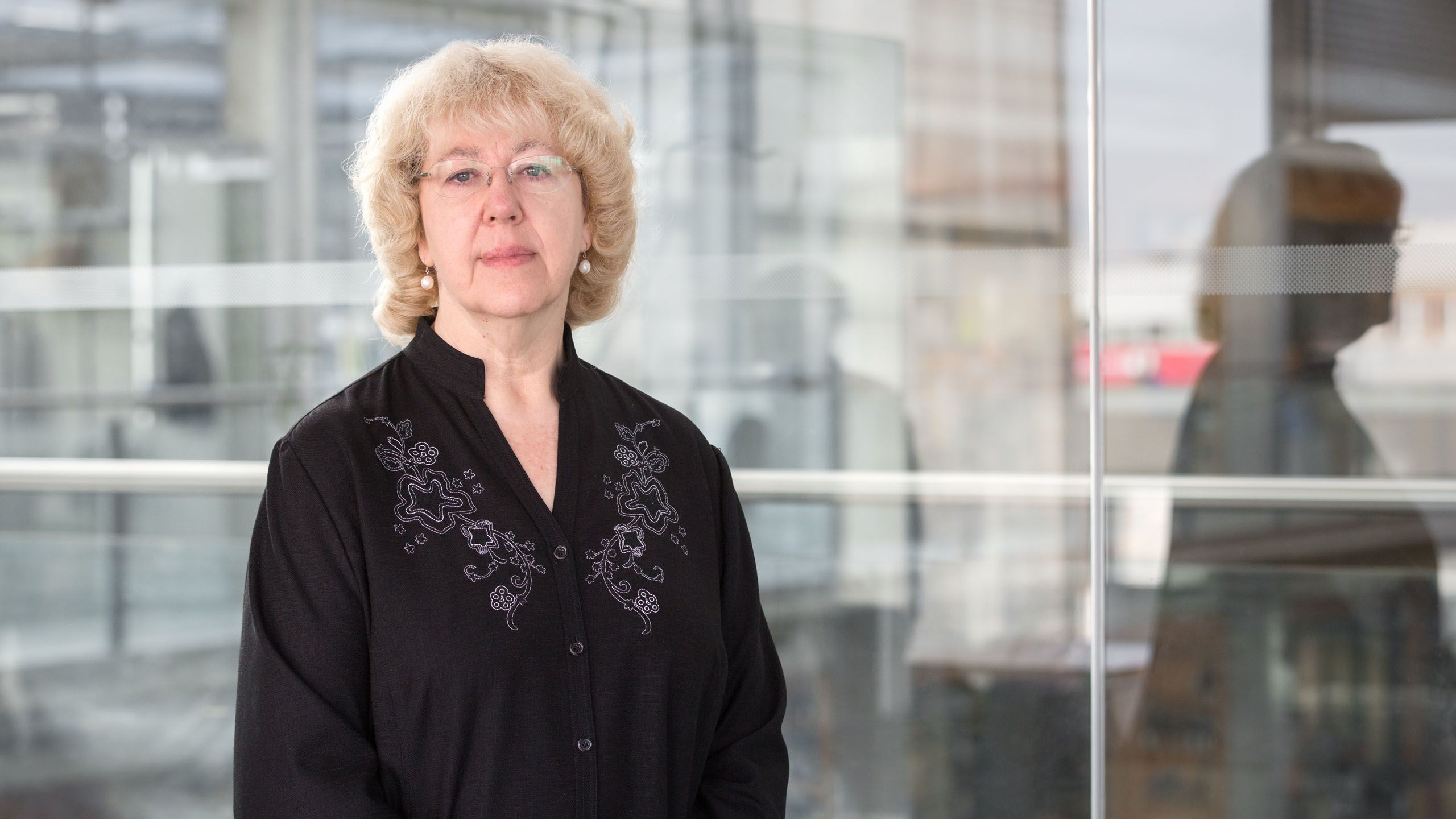
Professor Sian Harding and collaborators are growing patches of engineered cardiac muscle tissue to help patients following heart attacks.
Professor Sian Harding and collaborators are growing patches of engineered cardiac muscle tissue to help patients following heart attacks.
Tissue engineering
Sian Harding, Professor of Cardiac Pharmacology in Imperial's National Heart and Lung Institute, is also working at the cutting edge of tissue engineering. The treatment of heart attacks has improved in recent years; however, the muscle damage they cause leaves survivors unable to pump blood around the body effectively, resulting in symptoms such as fatigue and breathlessness. The body does a poor job of replacing the missing muscle tissue. Professor Harding’s team, along with collaborators in Nottingham and Hamburg, are growing patches of engineered cardiac muscle tissue to help patients following heart attacks.
The patches start out as stem cells, the body’s master cells that can grow into many different types. These can be mature skin cells that have been reprogrammed into stem cells or stem cells taken from embryos. Once large numbers have been grown, changes to the medium in which they are grown drive them to turn into heart muscle cells. Pushed together onto scaffolds, these form thumb-sized patches that begin to beat in synchrony and release compounds that help repair and regenerate existing heart tissue.
The muscle damage caused by heart attacks can leave survivors unable to pump blood around the body effectively, leaving them with symptoms such as fatigue and breathlessness. Professor Sian Harding and collaborators are growing patches of engineered cardiac muscle tissue using stem cells.
In research presented at a conference in 2019, Professor Harding’s group showed patches implanted into rabbits after heart attacks were being nourished by blood vessels growing into them from the heart. “We were able to show improved function, decreased scar sizes, and importantly, no arrhythmias.” Arrhythmias are abnormal heart rhythms and side effects seen in other experimental stem cell-based treatments.
Supported by funding from the British Heart Foundation, Professor Harding’s group is now seeking to better understand how the patches become synchronised with recipient hearts and is investigating the use of devices to ensure this happens safely. If successful, they hope to test the safety and efficacy of their patches in pigs and ultimately to a trial them in humans.
Following earlier work that helped reveal the molecular mechanisms underpinning the contraction of the heart, Professor Harding went on to lead the UK’s first myocardial gene therapy clinical trial, but the levels of gene transfer achieved were too low and the treatment failed to produce significant benefit in participants. She is now working with collaborators at King’s College London and UCL to use small, single-stranded sections of RNAs called microRNAs to improve the efficiency of adeno-associated viruses for future potential use in gene therapy to repair heart damage.
We’re talking about the use of cells, viruses and other live constructs, which are quite different to drugs. There’s a lot of infrastructure and training needed to make that happen.
Professor Harding says the Centre for Advanced Therapeutics and its collaborators in the field at King’s and UCL are laying the groundwork for the adoption of novel treatments by facilitating conversations between scientists and healthcare professionals. “We’re talking about the use of cells, viruses and other live constructs,” says Professor Harding, “which are quite different to drugs. There’s a lot of infrastructure and training needed to make that happen, and so we need to work with healthcare professionals in the NHS to understand how best we can deliver these complex products.”
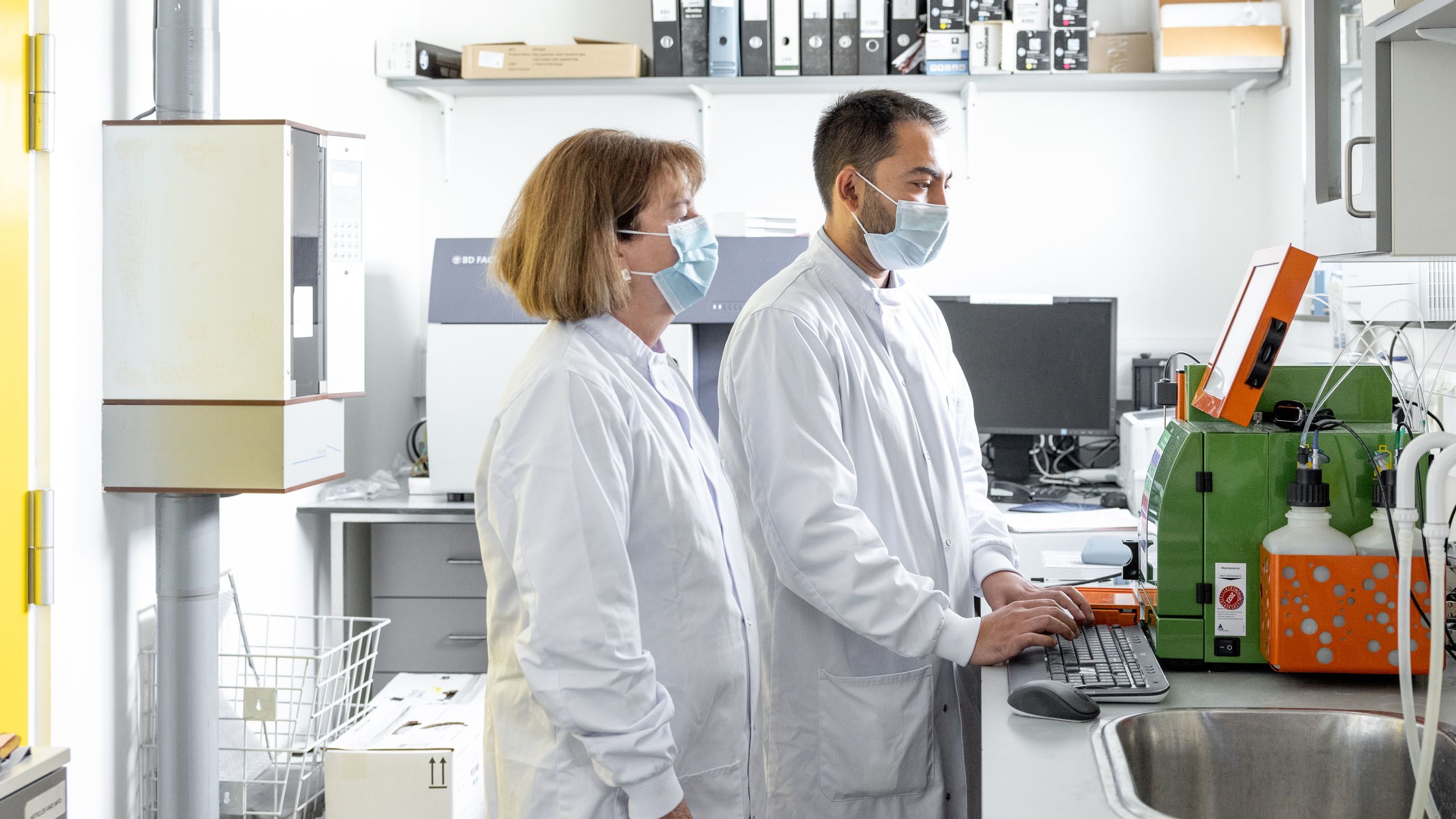
Jane Apperley, Professor of Haemato-oncology at Imperial and Clinical Director of Clinical Haematology at the Imperial College Healthcare NHS Trust, researches cell therapies such as CAR-T. She is pictured here with Shab Uddin, head of processing, with a machine used for CAR-T therapy. Photo: Thomas Angus
Jane Apperley, Professor of Haemato-oncology at Imperial and Clinical Director of Clinical Haematology at the Imperial College Healthcare NHS Trust, researches cell therapies such as CAR-T. She is pictured here with Shab Uddin, head of processing, with a machine used for CAR-T therapy. Photo: Thomas Angus
Cell therapy and haematology
Others associated with the Centre have been working with patients and their doctors to provide ATMPs for several years. Those in the field of haematology are among those with the most clinical experience.
“All of the individuals involved in our stem cell lab where we process the cells for transplants have become involved in translational research,” says Jane Apperley, Professor of Haemato-oncology, in Imperial’s Faculty of Medicine. “So while often the NHS and the College run along parallel but completely separate roads, with ATMPs in haematology we’re seeing an amazing partnership between the two.
Chemotherapy and radiation treatment severely undermines the immune systems of those who undergo it for cancers like leukaemia and multiple myeloma. Transplants of hematopoietic stem cells, from the bone marrow or the peripheral blood, have been provided to these patients for many years. These can involve using the patient’s own stem cells or those from a donor.
While the NHS and the College often run along parallel but separate roads, with ATMPs in haematology we’re seeing an amazing partnership between the two.
Haematologists have long removed immune system white blood cells called lymphocytes that come alongside stem cells from donors to avoid triggering graft-versus-host disease. Professor Apperley’s laboratory has been producing mesenchymal stem cells, which line the bone marrow, taken from donors as an ATMP treatment for graft-versus-host disease, for the last decade.
While avoiding graft-versus-host disease, the removal of lymphocytes that come with donor stem cells leaves recipients more vulnerable to viral infections and increases the chances of relapse. Epstein-Barr virus (EBV), for example, is common in humans and generally known as the cause of glandular fever. In stem cell transplant recipients, however, it can cause cancers of the lymphatic system.
Professor Apperley’s group has carried out important work to develop a solution called viral-specific T cell therapy. This involves taking lymphocytes from a donor previously infected, for example, with EBV, exposing them to EBV proteins and growing a pure population of T cells to infuse into stem cell transplant recipients to protect them from the virus. Professor Apperley’s team has developed the capability to provide in-house viral-specific T cell therapy for EBV and other viruses to hematopoietic stem cell transplant patients at Imperial.
Professor Apperley and her colleagues are also carrying out CAR-T cell therapy in which T cells are taken from patients, genetically engineered to include receptors that recognise cancer cells, grown up in a lab, and returned to the patients. Two CAR-T cell therapies were approved by the US FDA in 2017, however treatment can cost in the region of £250,000 per patient. Professor Apperley’s team recently gained approval to carry out a pilot study to do CAR-T cell therapy without the need to send patient cells to companies for processing, potentially cutting the cost around ten-fold.
CAR-T cell therapy does not use cells from donors because doing so would trigger graft-versus-host disease. Recent work by Tassos Karadimitris, Professor of Haemotology at Imperial, has shown in animal models that a specialised population of T cells called invariant natural killer T (iNKT) cells recognise tumours in a different way, opening up the possibility of engineering samples of these from donors to fight cancers in recipients.
Professor Apperley is working with Professor Karadimitris to investigate the therapeutic potential of iNKT cells. “Instead of extracting T cells from patients and hoping their disease doesn’t evolve during the time it takes to process them, these could be grown up from third-party donors and stored in the freezer as an off-the-shelf product,” say Professor Apperley.
She and other haematologists at Imperial are also providing cutting edge advanced therapy involving taking stem cells from sickle cell anaemia and thalassemia patients, sending them away to be genetically engineered by external companies and then returning them to patients.
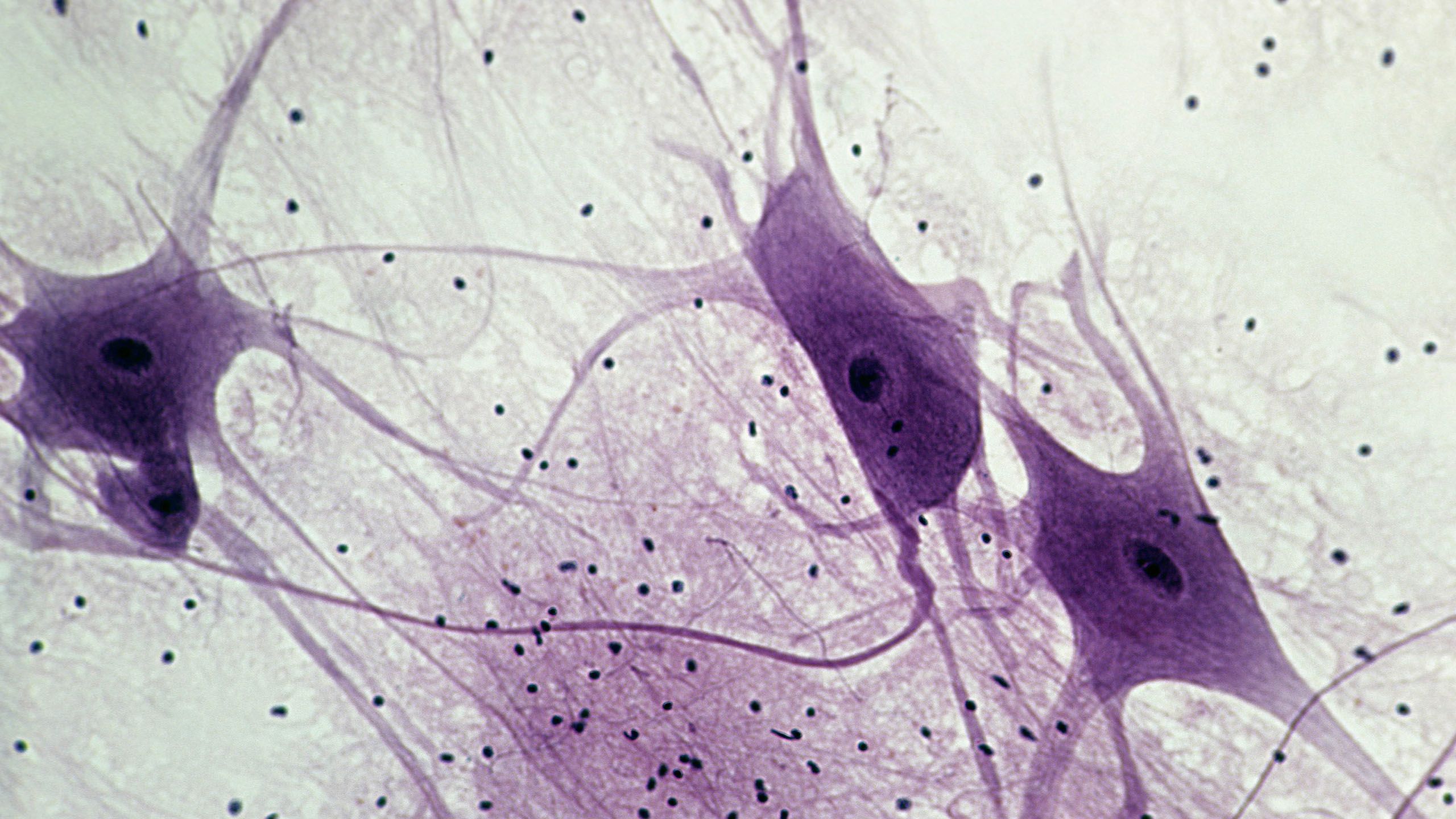
Close-up photo of neurons in the spinal cord. Professor Simone di Giovanni has identified a gene involved in regenerating dorsal root neurons following spine injury. This could eventually be harnessed in a gene therapy.
Close-up photo of neurons in the spinal cord. Professor Simone di Giovanni has identified a gene involved in regenerating dorsal root neurons following spine injury. This could eventually be harnessed in a gene therapy.
Spinal cord injury
While ATMPs have been transforming the lives of patients with blood disorders for many years, research on them is at an earlier stage in other fields. Professor Simone di Giovanni, Chair in Restorative Neuroscience at Imperial, is seeking to better understand the mechanisms that underpin repair and regeneration in the nervous system following following injury.
Professor Di Giovanni’s team does so by investigating some of the key cellular and molecular pathways responsible for the regeneration failure. One experimental approach his group uses is to compare what happens after injury in the peripheral nervous system, in which nerves have some capacity to grow back, with what happens in the spinal cord and brain, where damage is generally irreparable. Other techniques include providing animals with stimulating environments to increase their brain activity or making changes to their diets or exercise patterns to see how this affects the ability to repair damage.
Researchers compare what happens after injury in the peripheral nervous system, in which nerves have some capacity to grow back, with what happens in the spinal cord and brain, where damage is generally irreparable.
By introducing genetic modifications in target populations of neurons using adeno-associated viral vectors, Professor Di Giovanni has identified a number of key molecular pathways that could be targeted with interventions. In research published in December 2020, for example, his team observed that mice provided with stimulating environments saw greater regeneration of their dorsal root ganglia sensory neurons following spinal cord injury. They went on to identify the NOX2 gene as playing a key role in this finding. “We showed that gene transfer using this gene enhances axonal regeneration, synaptic function and sensory recovery in animals,” says Professor Di Giovanni. “You could in principle do this in humans.”
Professor Di Giovanni says there remain significant obstacles to overcome before clinical trials of gene therapy for spinal cord injury can begin, and highlights that his work could also inform the discovery of new small molecule drugs. As an associate of the Centre for Advanced Therapeutics, Professor Di Giovanni has access to a network of leading researchers in related fields to discuss his efforts to tackle these challenges.
The value of collaboration
“Sometimes you can become too focused on what is immediately in front of you,” says Dr Sanna. “Being in contact with others working in similar fields can help you open your mind and see things differently.”
Professor Shattock agrees that the potential for the Centre to bring together those with new perspectives based on their experiences of different disciples and sectors can be invaluable. “It provides opportunities to actively interact with people working to solve medical problems who may not have thought about the technology you’re working on as a possible solution, or may not have thought of it as accessible,” he says. “That helps bring about the interactive conversations, collaborative projects and partnerships needed for the perfect marriage between new technologies and unmet medical needs.”
This feature was commissioned by Enterprise, an Imperial team that helps industry partners benefit from the expertise of Imperial researchers, and helps Imperial staff and students turn ideas into world-changing innovations.
Learn more about how Imperial helps businesses in healthcare and other industries address their challenges at the Enterprise website.
